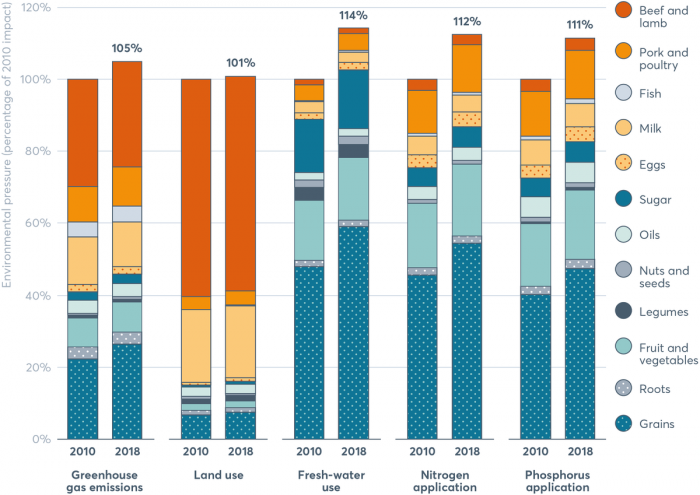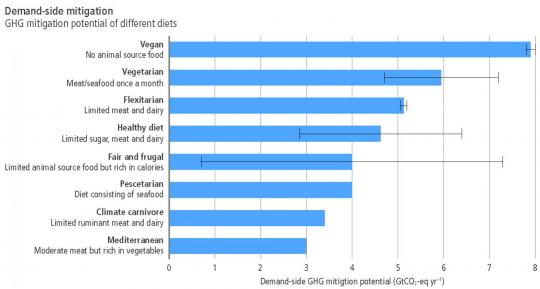Basic knowledge
To understand health and ecology, extensive basic knowledge is required. Here you will find fact-based texts and book reviews.
Table of contents
Introduction
Our future depends on the actions we take today. It is important that as many people as possible consciously move toward a plant-based diet so that they can maintain good health. At the same time, this is a sustainable diet that promotes change on a larger scale — in the target areas of environment, health, society, and animal welfare.
Through a healthy and nature-friendly eating style, people have the opportunity to greatly reduce their overall environmental impact. According to a study published in the journal Proceedings of the National Academy of Sciences in 2016, transitioning toward more plant-based diets that are in line with standard dietary guidelines could reduce food-related greenhouse gas emissions by 29–70 % compared with a reference scenario in 2050.12
The graphic below from Global Nutrition Report shows that the environmental impact of the food system is increasing. The graphic shows the effects on the individual environmental areas broken down by food group. As food consumption increased between 2010 and 2018, energy-intensive practices also increased. The graphic particularly highlights the growing and unsustainable impact of food groups such as beef, lamb and grains. In contrast, roots, legumes, and nuts and seeds have a relatively low and stable environmental impact.

Explanations of the graphic
Environmental pressure (percentage of 2010 impact): The impact of each food area on the environment for a specific environmental area. The 2018 data is a ratio of the 2010 values.
Environmental areas (from left to right): Greenhouse gas emissions, land use, fresh-water use, Nitrogen application, phosphorus application.
Food areas (from top to bottom): Beef and lamb, pork and poultry, fish, milk, eggs, sugar, oils, nuts and seeds, legumes, fruits and vegetables, roots, grains. One quickly recognizes the huge land claims and masses of harmful gases created by meat products (orange). On the other hand, for plant-based products, the problem is the amount of water and fertilizers - and pesticides. Pesticides can be avoided through organic quality; fertilization is just a question of intensity.
Health and nutrition
The World Health Organization (WHO) defines health as a state of complete physical, mental, and social well-being and not merely as the absence of disease or infirmity.2
Health and illness are the result of numerous and very different factors that are not always in our control. Depending on a person’s genetic constitution, they might be able to engage in a lot of unhealthy activities and not get ill, while another person will sooner or later develop some type of lifestyle disease.
We can make a positive contribution to our health by eating a healthy diet, exercising regularly, and getting enough sleep. But even if we do this, in rare cases there are endogenous factors such as genetic mutations that can result in serious diseases. In addition, exogenous stressors such as exhaust fumes, chemicals, allergens, and substances that we ingest through food put a heavy strain on our body. This is why proper nutrition and a healthy lifestyle are essential.
In addition, you should avoid all intoxicants as they can damage the immune and nervous systems. This includes alcohol abuse and smoking.3,4
Damage often accumulates unnoticed over decades until the body can no longer compensate. Your body can cope with this damage for a very long time, and you never know if you are really healthy — or for how long you will stay healthy. Even if there are, for example, old healthy smokers, these are exceptions.
A plant-based diet in particular can fulfill the role of a needs-based and healthy lifestyle. However, due to a lack of education on the subject, many view veganism as extreme and incapable of providing nutrients to the human body. On this website you will find practically all the information about raw vegan food and nutritional facts that show how you can optimally eat this diet. Eating a plant-based diet is an important step in maintaining your own physical and mental health and that of the planet.
Current food system
If you eat the current standard diet, it will be almost impossible for you to live a climate-friendly life. The food system is responsible for one-third of all human-made greenhouse gases worldwide. Land use, agriculture, and processes such as processing, packaging, and transport contribute equally to this.5
The bar graph below shows the connection between several types of diets and the mitigation potential (CO2-eqivalent) in gigatons per year. This information reflects the technical mitigation potential up to 2050 as described in the literature and includes the effects of carbon sequestration from land-saving (IPCC 2019).6 This chart points out that of all the efforts we humans make, it is changing our diet has the greatest impact. And this is especially true when we eat a plant-based diet. Below, you can see the effects of dietary change in the context of their ecological impact.

Explanations of the terms used in the chart
Vegan: completely plant-based. Combination of vegetables, legumes, fruits, seeds (grains and pseudo-grains), and nuts.
Vegetarian: plant-based, plus eggs and dairy.
Flexitarian: grains and legumes replace 75 % of meat and dairy consumption; at least 500 g of fruits and vegetables and at least 100 g of plant-based protein sources daily, modest amounts of animal proteins and limited amounts of red meat (once a week); small amounts of refined sugar (less than 5% of total energy).
Healthy diet: based on global dietary guidelines for the consumption of red meat, sugar, fruits, and vegetables.
Fair and frugal: global daily per-capita caloric intake of 2800 kcal/capita/day (11.7 MJ/capita/day) and relatively low amounts of animal products.
Pescetarian: vegetarian diet (dairy products and eggs, but no meat) with seafood and fish.
Climate carnivore: 75 % of ruminant meat and dairy products replaced with other types of meat (e.g., chicken).
Mediterranean: predominantly vegetables, fruits, grains, sugars, oils, eggs, dairy, and seafood, as well as modest amounts of poultry, pork, lamb, and beef.
If we want to reach our climate goals, we must make fundamental structural changes in our eating habits, taking into account the interrelationships between ecological, social, political, cultural and economic aspects.
With regard to a sustainable food system, the European Commission proposes climate-friendly transformations in the areas of production, processing, distribution of goods, consumption, and the avoidance of food waste. When considered together, areas that sometimes sound controversial (e.g., production and consumption, agroecology and industry, and technology and social affairs) can also find possible solutions.7
EE summarizes targeted measures as follows: This is, for example, fruits and vegetables from organic farming that are as regional as possible, or farms based on the model of Community Supported Agriculture (CSA model). The focus is on improved irrigation methods, working methods that protect the soil, attention to animal welfare, and purchase guarantees for farmers.
If we choose organic food, then we are also avoiding chemical inputs such as broad-spectrum herbicides including glyphosate (brand name Roundup). Glyphosate is the world’s best-selling herbicide today. It enters the cycle through food and animal feed and has serious consequences for us, and for plants and animals.
Life cycle assessment and our future
The concept of life cycle assessment and sustainable nutrition are interrelated and multidimensional; thus there are different perspectives that allow us to assess the value of a food. The term “compatibility” is used here: Depending on the dimension, one speaks of health compatibility, social compatibility, economic compatibility or environmental compatibility. Furthermore, sustainable nutrition is also an instrument with which the climate situation can be fundamentally improved. You can find out more about grassroots movements in the article Ecology: Grassroots movements and political action required. Here is a brief explanation of the meaning of grassroots journalism (participatory journalism or citizen journalism). The grassroots movement (in the USA since 1912) gave rise to a form of journalism in which civil society participates in social discourse within the traditional media or through its own media. There is an anarcho-pacifist magazine about it in German, which in this form tends to damage the idea of a movement from below. Raised differently, it is particularly important.
The term “life cycle assessment” refers to a standardized method used to determine the life cycle of a product in the form of quantitative results. This is from beginning to end, known as “cradle to cradle” (according to Braungart and McDonough), that is, from the birth or cradle of one generation to the cradle of the next generation. This approach is also known as life cycle analysis. You can use it to record and evaluate environmentally relevant processes (e.g., of products). The creation of life cycle assessments is defined according to the German standards DIN EN SO 14040 and DIN EN ISO 14044.8
The environmental compatibility or ecological footprint is checked using well-known methods such as the CO₂ footprint, the water footprint (water consumption) or through so-called sustainability ratings. These calculation methods are intended to reveal the limits of our earth's biocapacity. One aspect of this could be covered with sustainably oriented systems such as organic farming.9
In order to draw attention to changes that need to be made, we include the seasonal availability for as many foods as possible. In this way, we hope to create awareness of when a product is commercially available in the region, when it is imported via local transport or comes to us from “far away” by ship or plane.
The wohole topic of life cycle assessment is now also called planetary health as a new, multidisciplinary research paradigm. Planetary health provides a new comprehensive concept of health, as well as an emerging field of health science. It focuses not only on the health of humans, but also on the health of other living beings and all ecosystems.10 This term planetary health was coined by the Rockefeller Foundation – Lancet Commission on Planetary Health in 2015.11
Basic understanding of health and nutrition
What is healthy eating? How do you get proper exercise? Why are these important? We answer these questions through detailed book reviews and other fact-based texts that you can access via the following link. We have sorted these texts according to their importance:
Basic understanding of health and nutrition
EE: Think of the body as a complex factory that assembles a number of entirely different complicated products, where the individual parts have to arrive ‘just in time’ and in the right quantity, not too much or too little, because that would slow down the process or leave the product incomplete. The optimum of all parts needs to be achieved and never the maximum. And this is why we have included several nutrient tables with all of our recipes and ingredients — and have also linked them to the article A vegan dietc can be unhealthy. This article will give you an understanding of the most important basics about health and nutrition.
You can also find more information in the following categories:
Videos
Click on the link below to see an overview of some interesting and important videos. Videos have the advantage that they can clearly explain certain concepts and relationships, for example, about health, nutrition, sports, and other aspects that promote our health. In addition, it is important to us that people also know about animal welfare and threats that make our Earth uninhabitable for us (and earlier for many other species).
Among the videos presented you will also find the 6-minute, extremely impressive lecture by Severn Suzuki, then aged 12, at a UN conference in 1992. What is shocking to us is how little it achieved there. This despite her understandable, moving and admonishing words about the future of our earth. A similar story happened to the actually shocking first report of the Club of Rome from 1972. This club is an association of highly esteemed experts in various disciplines from more than 30 countries. After all, there was a global but controversial discussion with numerous echoes back then.
You can search for videos based on their length (under 7, 15, and 30 minutes as well as over 30 minutes), the title, producer, rubric, and/or platform. The second of the two links has a lot to offer, especially on the subject of exercise, its importance and the mobilization of various muscle groups.
General posts
Click on the link below to go to our blogs (general posts). These include personal accounts and short texts on a variety of topics related to health and nutrition. These are not as long and detailed as the texts under the category “Basics,” where there are also detailed book reviews. Here you will also read articles on how to achieve healthy and good sleep - something that unfortunately more and more people are struggling with and that affects our quality of life.
Personal accounts and short texts
Reviews and abstracts
Currently, we have very few book reviews because we are currently focusing our efforts on the descriptions of ingredients, but we would like to expand this at a later point. In addition, we are going to translate the book reviews into other languages. We do have some comprehensive book reviews in German. These reviews take the form of long abstracts and cover the books’ most important information.
The information in our basic texts and in our descriptions of foods and nutrients are based on the latest evidence and scientific studies, and we quote numerous scientific studies and papers here. We have only published abstracts or our own descriptions of a few studies. Wherever this is the case, we provide a link to the scientific paper (at least to the original abstract, mostly in English). The list of these studies appears under the following link:
Cookbooks and raw food
These are not really basics, but practical applications. We also discuss this topic in the recipes (see article Recipes with ingredients), but we want to provide a direct insight here too.
We provide descriptions of about 75 vegan cookbooks, and we have selected three recipes from each (vegan recipes) to share with you on our site. Furthermore, we also describe some other sites with recipe blogs.
You will find reviews of these cookbooks and blogs (written by us) that highlight particularly good elements, but also point out nutrition and diet mistakes. This is necessary because many authors focus on appearance or taste rather than health aspects. The reason for this is that they have to do so in order to have commercial success.
This link takes you to all the cookbooks we have discussed. For those who are only interested in raw vegan food, here is the direct link: Cookbooks vegan or raw diet. However, you can also restrict the selection by using the main link and activating the checkbox “Raw-vegan recipe books only.” These cookbooks are interesting to all, not only for raw food lovers! In addition, we list some good raw food recipe blogs.
More information about the website
Please note that we don’t sell anything, and we don’t bother you with advertisements either! Instead, our website offers hundreds of vegan recipes and descriptions of vegan foods (ingredients), each with a list of the nutrients they contain.
You can register at the top right of the website to receive our free newsletter (max. two newsletters per year). In addition, we offer registered users information about vegan restaurants around the world. Please also note the links (e.g., imprint, contact, and data protection) at the bottom left and the QR code (link to the page currently open) at the bottom right of the website.
Bibliography - 12 Sources
| 1. | Jungbluth N, Ulrich M, Muir K, Meili C, Bussa M, Solin S. Analysis of food and environmental impacts as a scientific basis for Swiss dietary recommendations. ESU-services GmbH, Schaffhausen, Switzerland. 2022. |
| 2. | Fedlex: Verfassung der Weltgesundheitsorganisation 0.810.1 (deutsche Übersetzung). Stand 2020. |
| 3. | Oscar-Berman M, Shagrin B, Evert DL, Epstein C. Impairments of brain and behavior: the neurological effects of alcohol. Alcohol Health Res World. 1997;21(1):65–75. |
| 4. | Durazzo TC, Rothlind JC, Gazdzinski S, Banys P, Meyerhoff DJ. Chronic smoking is associated with differential neurocognitive recovery in abstinent alcoholic patients: a preliminary investigation. Alcoholism Clin Exp Res. 2007;31(7):1114–1127. |
| 5. | Crippa M, Solazzo E, Guizzardi D, Monforti-Ferrario F, Tubiello FN, Leip A. Food systems are responsible for a third of global anthropogenic GHG emissions. Nat Food. 2021;2(3):198–209. |
| 6. | Mbow C, Rosenzweig C, Barioni LG et al. Food Security. In: Climate Change and Land: an IPCC special report on climate change, desertification, land degradation, sustainable land management, food security, and greenhouse gas fluxes in terrestrial ecosystems. 2019. |
| 7. | Penker M, Brunner KM, Plank C. Kapitel 5. Ernährung. In: Görg C, Madner V et al. APCC Special Report: Strukturen für ein klimafreundliches Leben. Rochester, NY: Social Science Research Network; 2023. |
| 8. | Umweltbundesamt.de Ökobilanz. 2018. |
| 9. | Gottwald FT. Kulturwandel auf dem Teller. Pflanzliche Alternativen zu Lebensmitteln tierischen Ursprungs – eine ernährungsökologische Einschätzung. Schwerpunkt "Welt im Fieber - Klima & Wandel". Der kritische Agrarbericht 2021. |
| 10. | Gabrysch S. Klimakrise und Gesundheit – eine Planetary-Health-Perspektive. Journal of Health Monitoring. 2022;7(S4). |
| 11. | Whitmee S, Haines A et al. Safeguarding human health in the Anthropocene epoch: report of The Rockefeller Foundation–Lancet Commission on planetary health. The Lancet. 2015 Nov;386(10007):1973–2028. |
| 12. | Springmann M, Godfray HCJ, Rayner M, Scarborough P. Analysis and valuation of the health and climate change cobenefits of dietary change. Proc Natl Acad Sci. 2016;113(15):4146–4151. |


Comments